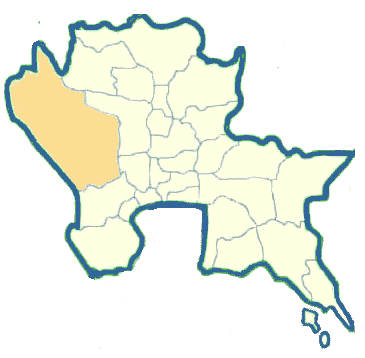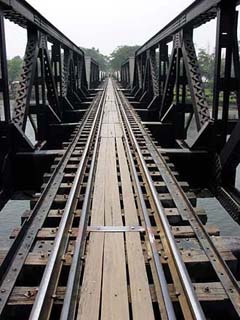Kanchanaburi Province in Central Thailand

Kanchanaburi is one of the most beautiful provinces of Thailand with a very delightful landscape. It is already well-known among War-historians and movie-buffs as the site of the notorious "Death Railway" and the "Bridge Over the River Khwae". Archaeologists know it for its Neolithic burial grounds. Yet, the province also has numerous other places of interest for the nature loving visitor.
Kanchanaburi is about 128 kilometers west of Bangkok approximately 2 1/2 hours ride by car over a good road. The town of Kanchanaburi is located at the point where two tributaries, the Khwae Noi and Khwae Yai (which have their source in the Ta-Nao-Si Range) meet and form the Mae-Klong River.
The present provincial capital is a relatively new town built by King Rama III in 1833. The old town was 18 kilometers away.
What to see and what to do in Kanchanaburi?
Directory listings : Hotels in Kanchanaburi
The Bridge over the River Kwai is located about 4 kilometers from the T.A.T. office, on the bank of the Khwae Yai River. It was brought from Java by the Japanese Army and was assembled at the River Khwae by war prisoners. Bombed several times in 1945, it was rebuilt after the war. The curved spans of the bridge are the original sections. An estimated 16,000 war prisoners and 49,000 impressed laborers died during the construction of the bridge and the Death-Railway line that leads to Burma.

Bridge over River Kwai, Kanchanaburi
Tham Khao Pun cave is located about 1 kilometer from the Chong-Kai War Cemetery. There is a temple in front of the cave. This cave houses many beautiful Buddha images of different gestures which make your climb worthwhile. The stalactites and stalagmites are also interesting.
Ban Kao National Museum is built near a Neolithic burial site, that was discovered by a Dutch P.O.W., while working on the Death Railway. The museum is 35 kilometers out of town on a branch road off the Asian Highway. On display are specimens of Neolithic remains and utensils.
Prasat Muang Singh Historical Park : Beyond the Ban Kao Neolithic Museum about 10 Kms. up north, is "Prasat Muang Singh" ruin. Renovated by the Fine Art Department to display Khmer influenced architecture on this part of Thailand some 700-800 years ago. Archaeologists should never miss this site, it is very interesting and has a perfect atmosphere for study and relaxation within this green park. The entrance fee is Bt 20/person.
Hell Fire Pass : Once part of the Death Railway during the World War II, the pass is located near Kilometer marker 66 on the Sai Yok-Thong Pha Phum Road but is now abandoned.
Sai Yok Waterfall : A classic Thai song gained immortality by the way it eulogizes the idyllic beauty of Sai Yok Falls. Now a part of a National Park, the falls are 104 kilometers from Kanchanaburi on the Asian Highway which runs north from Kanchanaburi to its northern most district Sangkhla on the Thai-Burmese border. At Km 104 is the left-hand entrance to the Sai Yok National Park on the bank of Khwae Noi River. The Sai Yok Waterfalls are on the same side of the river, to the left. A new high-tensile wire-rope suspension bridge was strung across recently so tourists can get the full visual impact of the waterfalls. Accommodation in the form of raft houses by this bridge is provided for tourists. On the other side is a sand bank, from where Sai Yok Falls can be appreciated full face.
Khao Phang or SaiYokNoi WaterFall is about 2 kilometers from the present end of the "Death Railway" line which is called Nam-Tok Station. It is about 77 Kms. from Kanchanaburi. The trip to this place would be interesting for those who like to travel the noterious "Death Railway" route once. The countryside and the landscape are among the most beautiful in Thailand.
However, during the dry season (September-April) there is not much water so you may not enjoy swimming at the waterfall. Therefore, the best time for visiting this waterfall is in the rainy season. The trip by bus takes about 2 hours. Riding on the bus allow for good sight-seeing for those visitors who have time.
A boat ride to Tham Kaeng Lawa and Sai Yok Waterfall will give you a very pleasant and adventurous experience that can hardly be forgotten. This part of the Khwae Noi is very rich with scenic beauties, wild animals and a riverview. Kaeng Lawa Cave is one of your interesting spots to visit. It is the biggest cave in the area. The stalactites and stalagmites are so wonderful and naturally peculiar. After this visit, you can continue to the Sai Yok Yai Waterfall which is very enchanting for everyone. If your time allows, it is a must.
You can hire a boat from Pak Saeng Pier at Tam-Bon Tha Sao. One boat can carry 10-12 persons. It takes about 2 1/2 hours upstream to Sai Yok and 1 1/2 hours downstream (return-trip).Erawan National Park, 65 kilometers from Kanchanaburi along Route 3199, is the site of the 7-tiered Erawan Waterfall, widely regarded as being one of Thailand's loveliest cascades. The 550-square-kilometre national park enjoys a mountainside forest setting. Dense bamboo groves support numerous bird species. The park's other major attraction is the spectacular Phrathat Cave which contains monumental stalagmites. Bungalow accommodation and camping facilities are available.
One can get to this place by a local bus departing from the bus terminal in Kanchanhuri. The trip will take about 1 1/2 hours.
Si Nakharin Dam is five kilometers further up the same road from Erawan Falls. It is an impressive major hydroelectric power plant project. At the dam-site, a sizable superbly planned complex of project personnel housing, recreation centers and guest residences. These are blended incongruously into the high rocky hillsides supporting the 300 feet high concrete dam.
Huai Khamin Waterfall : From the Si Nakharin Dam, a two hour's boat trip on the vast reservoir brings visitors to the picturesque Huai Khamin Waterfall in the Si Nakharin National Park.
The water cascades down an ochre limestone rock face to the tree-lined bank on the quiet shore of the reservoir. So remote a part of jungle, so far away from civilization that it seems the jungle will close back over the waterfalls, once the tour boat is out of sight.
Tham Than Lot National Park or Chalerm Rattanakosin National Park is located 97 kilometers from Kanchanaburi. There is regular bus service between Kanchanaburi and Ban Nong Pru from where a mine-bus can be hired to the park. The park has beautiful caves such as Tham Than Lot Noi and Tham Than Lot Yai. It has mighty waterfalls such as Than Ngoen and Nam Tok Than Thong.
The Three Pagodas line up between Thailand and Myanmar as the border at the northernmost point in Amphoe Sangkhla Buri about 18 kilometers from Amphoe Thong Pha Phum. Near the Pass on the other side of the border is a small community and market of Mon people who sell goods to tourists.
Khao Laem Dam is an hydroelectric dam situated on Khwae Noi River about 6 kilometers north of Amphoe Thong Pha Phum and about 147 kilometers north of the provincial city on highway no. 323. With its length and height of 1019 and 92 meters respectively the dam forms a great reservoir which is home to many raft-houses resorts.
Wat Wang Wiwegaram is situated on the hill side in Amphoe Sangkhla Buri. By looking down from this place one can see a beautiful lake formed by three rivers. Wat Wang Wiwegaram is well known and respected not only by the Thai people but also by many local tribal people, such as, Mons, Karens and Burmeses. Its Pagoda was built in the style of Phara Phuttha Khaya in India. In its temple is housed a huge Buddha Image made of marble.
